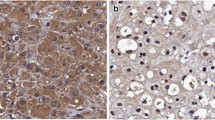Abstract
The prognosis of chordomas is difficult to predict based solely on histological findings. The purpose of this study was to assess the immunohistochemical expression of the proliferation marker Ki-67 antigen and the expression of p53 in skull base chordomas and to relate their expressions to the outcome. We examined the expression of p53 and the MIB-1 labeling index (LI), assessed by Ki-67 expression, in 19 tumors (initial, n = 11; recurrent, n = 8) from 11 patients. The correlation among the MIB-1 LI, p53 expression, and the clinical outcome was analyzed. The mean MIB-1 LI and p53 expression at the initial surgery were 5.6 ± 4.6% and 9.0 ± 9.4%, respectively. At the time of recurrence, the mean MIB-1 LI and p53 expression were 10.2 ± 7.4% and 16.5 ± 12.0%. The correlation between the MIB-1 LI and p53 expression at the initial and recurrent surgeries was highly significant (r = 0.948; P < 0.0001). The change in p53 expression from the initial to the recurrent chordomas was significantly greater in patients who died of tumor-related causes than in the surviving patients. In the surviving patients, the values for MIB-1 LI and p53 expression in the recurrent tumors were significantly higher in the disease-ongoing group than in the disease-free group. Our results suggest that determination of the immunohistochemical expression of p53 and Ki-67 antigen is helpful to predict tumor recurrence and prognosis in skull base chordomas.
Similar content being viewed by others
References
ML McMaster AM Goldstein CM Bromley et al. (2001) ArticleTitleChordoma: incidence and survival patterns in the United States, 1973–1995 Cancer Causes Control 12 1–11 Occurrence Handle11227920 Occurrence Handle10.1023/A:1008947301735 Occurrence Handle1:STN:280:DC%2BD3M3ksVylug%3D%3D
HA Crockard T Steel N Plowman et al. (2001) ArticleTitleA multidisciplinary team approach to skull base chordomas J Neurosurg 95 175–183 Occurrence Handle11780885 Occurrence Handle1:STN:280:DC%2BD38%2FlsFGitg%3D%3D
MN Pamir T Kilic U Ture et al. (2004) ArticleTitleMultimodality management of 26 skull-base chordomas with 4-year mean follow-up: experience at a single institution Acta Neurochir (Wien) 146 343–354 Occurrence Handle10.1007/s00701-004-0218-3 Occurrence Handle1:STN:280:DC%2BD2c7mt1KgsA%3D%3D
PA Forsyth TL Cascino EG Shaw et al. (1993) ArticleTitleIntracranial chordomas: a clinicopathological and prognostic study of 51 cases J Neurosurg 78 741–747 Occurrence Handle8468605 Occurrence Handle1:STN:280:DyaK3s3isV2ksw%3D%3D
M Hollstein D Sidransky B Vogelstein et al. (1991) ArticleTitlep53 mutations in human cancers Science 253 49–53 Occurrence Handle1905840 Occurrence Handle10.1126/science.1905840 Occurrence Handle1:CAS:528:DyaK3MXks1Gmurg%3D
DP Lane (1992) ArticleTitlep53, guardian of the genome Nature 358 15–16 Occurrence Handle1614522 Occurrence Handle10.1038/358015a0 Occurrence Handle1:STN:280:DyaK38zhtVGmtA%3D%3D
JM Nigro SJ Baker AC Preisinger et al. (1989) ArticleTitleMutations in the human p53 gene occur in diverse human tumour types Nature 342 705–708 Occurrence Handle2531845 Occurrence Handle10.1038/342705a0 Occurrence Handle1:CAS:528:DyaK3cXkvFyhug%3D%3D
T Naka C Boltze D Kuester et al. (2005) ArticleTitleAlterations of G1-S checkpoint in chordoma Cancer 104 1255–1263 Occurrence Handle16078265 Occurrence Handle10.1002/cncr.21296 Occurrence Handle1:CAS:528:DC%2BD2MXhtVOrtrnO
C Rodriguez-Pereira JM Suarez-Penaranda M Vazquez-Salvado et al. (2000) ArticleTitleValue of MIB-1 labeling index (LI) in gliomas and its correlation with other prognostic factors. A clinicopathologic study J Neurosurg Sci 44 203–209 Occurrence Handle11327289 Occurrence Handle1:STN:280:DC%2BD3MvntlWjsA%3D%3D
A Tortosa N Vinolas S Villa et al. (2003) ArticleTitlePrognostic implication of clinical, radiologic, and pathologic features in patients with anaplastic gliomas Cancer 97 1063–1071 Occurrence Handle12569607 Occurrence Handle10.1002/cncr.11120
P Bergh LG Kindblom B Gunterberg et al. (2000) ArticleTitlePrognostic factors in chordoma of the sacrum and mobile spine. A study of 39 patients Cancer 88 2122–2134 Occurrence Handle10813725 Occurrence Handle10.1002/(SICI)1097-0142(20000501)88:9<2122::AID-CNCR19>3.0.CO;2-1 Occurrence Handle1:STN:280:DC%2BD3c3ntlCqtA%3D%3D
T Naka C Boltze A Samii et al. (2003) ArticleTitleSkull base and nonskull base chordomas. Clinicopathologic and immunohistochemical study with special reference to nuclear pleomorphism and proliferative ability Cancer 98 1934–1941 Occurrence Handle14584077 Occurrence Handle10.1002/cncr.11756
JL Holton T Steel M Luxsuwong et al. (2000) ArticleTitleSkull base chordomas: correlation of tumour doubling time with age, mitosis and Ki67 proliferation index Neuropathol Applied Neurobiol 26 497–503 Occurrence Handle10.1046/j.1365-2990.2000.00280.x Occurrence Handle1:STN:280:DC%2BD3M7gtV2qsA%3D%3D
A Matsuno T Sasaki T Nagashima et al. (1997) ArticleTitleImmunohistochemical examination of proliferative potentials and the expression of cell cycle-related proteins of intracranial chordomas Hum Pathol 28 714–719 Occurrence Handle9191006 Occurrence Handle10.1016/S0046-8177(97)90181-7 Occurrence Handle1:STN:280:DyaK2szjsVejuw%3D%3D
S Kilgore RA Prayson (2002) ArticleTitleApoptotic and proliferative markers in chordomas: a study of 26 tumors Ann Diagn Pathol 6 222–228 Occurrence Handle12170453 Occurrence Handle10.1053/adpa.2002.35397
T Naka T Fukuda H Chuman et al. (1996) ArticleTitleProliferative activities in conventional chordoma: a clinicopathologic, DNA flow cytometric, and immunohistochemical analysis of 17 specimens with special reference to anaplastic chordoma showing a diffuse proliferation and nuclear atypia Hum Pathol 27 381–388 Occurrence Handle8617482 Occurrence Handle10.1016/S0046-8177(96)90112-4 Occurrence Handle1:STN:280:DyaK287osFagtw%3D%3D
R Pallini G Maira F Pierconti et al. (2003) ArticleTitleChordoma of the skull base: predictors of tumor recurrence J Neurosurg 98 812–822 Occurrence Handle12691407 Occurrence Handle10.3171/jns.2003.98.4.0812
Author information
Authors and Affiliations
Corresponding author
Rights and permissions
About this article
Cite this article
Sakai, K., Hongo, K., Tanaka, Y. et al. Analysis of immunohistochemical expression of p53 and the proliferation marker Ki-67 antigen in skull base chordomas: relationships between their expression and prognosis. Brain Tumor Pathol 24, 57–62 (2007). https://doi.org/10.1007/s10014-007-0222-4
Received:
Accepted:
Published:
Issue Date:
DOI: https://doi.org/10.1007/s10014-007-0222-4




